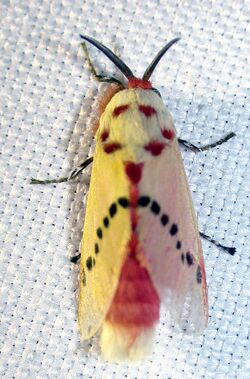Biology:Trosia dimas
| Trosia dimas | |
|---|---|

| |
| Scientific classification | |
| Domain: | Eukaryota |
| Kingdom: | Animalia |
| Phylum: | Arthropoda |
| Class: | Insecta |
| Order: | Lepidoptera |
| Family: | Megalopygidae |
| Genus: | Trosia |
| Species: | T. dimas
|
| Binomial name | |
| Trosia dimas (Cramer, 1775)
| |
| Synonyms | |
| |
Trosia dimas, the rosy ermine, is a moth in the family Megalopygidae. It is found in Colombia, Venezuela, Ecuador, Brazil, and Peru.
Taxonomy
The first description of this species was by Pieter Cramer in 1775, who named it Bombyx dimas.[1] Subsequent authors placed it in the genera Chrysauge, Idalus, and Sciathos until Harrison Dyar, following Hübner in 1822, assigned it to Trosia, where it has remained.[2]
Description
This species has a wingspan of about 34 millimetres (1.3 in). The head, abdomen, and legs are reddish and the tarsi black, spotted with white. The collar and thorax are yellowish buff, the latter spotted with red. The forewings are greenish yellow, with a postmedial row of black spots. The hindwings are roseate. The underside is dull roseate. In this species, the costa of the forewings is of the same color as the wing.[3]
Habitat
Trosia dimas is found in rainforests and cloud-forest at altitudes between 300 and 1,700 meters (980 and 5,580 ft).[4] The Byrsonima coccolobifolia is the host plant of Trosia dimas.[5]
Range
Trosia Dimas has been observed in Colombia, Venezuela, Ecuador, Brazil and Peru.[4] Observations recorded in various collections and citizen science initiatives suggest the range where this species occurs is from South America to North America[6]
Taxonomy
Trosia dimas is a species in the genus Trosia.[6] It was first described by Pieter Cramer in 1775.[6]
References
- ↑ Beccaloni, G.; Scoble, M.; Kitching, I. et al., eds (2003). "Trosia dimas". The Global Lepidoptera Names Index. Natural History Museum. https://www.nhm.ac.uk/our-science/data/lepindex/detail/?taxonno=75668.
- ↑ , Wikidata Q104144767
- ↑ Schaus, William (1906). "Descriptions of new South American moths". Proceedings of the United States National Museum 29: 179–345. https://www.biodiversitylibrary.org/item/53438#page/357/mode/1up.
- ↑ 4.0 4.1 "Moths of the Andes - Trosia dimas". http://www.learnaboutbutterflies.com/Andes%20-%20Trosia%20dimas.htm.
- ↑ Diniz, I. R., Morais, H. C., & Camargo, A. J. A. (2001). Host plants of lepidopteran caterpillars in the cerrado of the Distrito Federal, Brazil. Revista Brasileira de Entomologia, 45(2), 107-122.
- ↑ 6.0 6.1 6.2 Registry-Migration.Gbif.Org (2019) (in en), GBIF Backbone Taxonomy, GBIF Secretariat, doi:10.15468/39omei, https://www.gbif.org/dataset/d7dddbf4-2cf0-4f39-9b2a-bb099caae36c, retrieved 2020-12-19
Wikidata ☰ Q14508381 entry
 |


